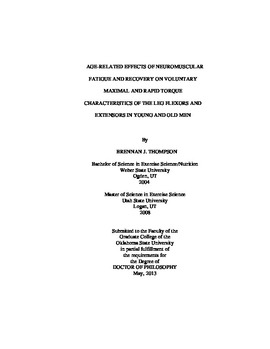| dc.contributor.advisor | Smith, Doug | |
| dc.contributor.author | Thompson, Brennan J. | |
| dc.date.accessioned | 2014-09-24T14:16:45Z | |
| dc.date.available | 2014-09-24T14:16:45Z | |
| dc.date.issued | 2013-05 | |
| dc.identifier.uri | https://hdl.handle.net/11244/10992 | |
| dc.description.abstract | The purpose of the present study was to examine the effects of acute neuromuscular fatigue and recovery on maximal and rapid torque characteristics in young and old men for the knee extensors and flexors. Twenty-one young (mean+/-SD:age=24.76 years) and nineteen old (age=72.05+/-3.60 years) men performed maximal voluntary contractions (MVCs) prior to performing a fatigue-inducing bout of sub-maximal, intermittent isometric contractions using a .6 duty cycle at 60% of MVC until volitional fatigue. MVCs were then performed again at immediately after, 7, 15, and 30min following the completion of the fatigue task. Endurance time was the elapsed time from onset until failure during the course of the fatigue protocol. Maximal (peak torque; PT) and rapid (absolute and relative rate of force development; RFD and nRFD, respectively) torque characteristics were calculated from the torque-time curves for each time period. Three-way mixed factorial ANOVAs (muscle [knee extensors vs leg flexors] x age [young vs old men] x time period [Pre vs Post vs Recovery 7 vs Recovery15, vs Recovery30) were used to analyze all maximal and rapid torque variables. The present findings revealed that older men had greater overall endurance times compared to young men. No differences were observed in the fatigue-induced reductions immediately following the fatigue task for the absolute rapid force characteristics among early and late phases of the torque-time curve, muscles, and age groups. However, differential recovery patterns were observed for PT, and early and late RTD phases between the knee extensor and flexor muscle groups such that the early rapid torque variables (RTD30 and RTD50) and the knee flexors demonstrated slower recovery compared to later rapid torque variables (>RFD100) and the knee extensors. The normalized RTD variables declined to a lesser extent following the fatigue task and differential muscle and group effects were observed where the knee flexors were reduced more at the early phase (nRTD1/6) compared to the knee extensors, however, for the later phase (nRTD2/3) the young men exhibited a significantly greater reduction compared to the old men. These findings may have important fatigue related performance, and injury risk implications for a variety of populations and settings. | |
| dc.format | application/pdf | |
| dc.language | en_US | |
| dc.rights | Copyright is held by the author who has granted the Oklahoma State University Library the non-exclusive right to share this material in its institutional repository. Contact Digital Library Services at lib-dls@okstate.edu or 405-744-9161 for the permission policy on the use, reproduction or distribution of this material. | |
| dc.title | Age-related effects of neuromuscular fatigue and recovery on voluntary maximal and rapid torque characteristics of the leg flexors and extensors in young and old men | |
| dc.contributor.committeeMember | Warren, Aric | |
| dc.contributor.committeeMember | Jacobson, Bert | |
| dc.contributor.committeeMember | Dicks, Michael | |
| osu.filename | Thompson_okstate_0664D_12639.pdf | |
| osu.accesstype | Open Access | |
| dc.type.genre | Dissertation | |
| dc.type.material | Text | |
| thesis.degree.discipline | Health, Leisure, and Human Performance | |
| thesis.degree.grantor | Oklahoma State University | |
